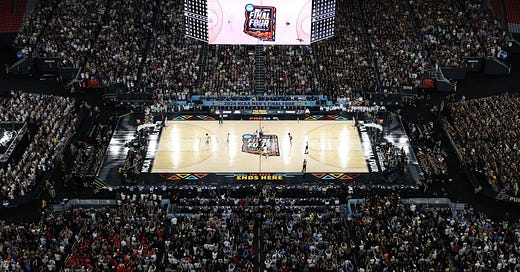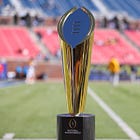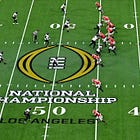Barnhouse: The "Eight Teams Project" '25
YVS is back with his method for picking the winner for this year's NCAA Tournament.
NOTE FROM BOB: Wendell is back! Time for another guest piece from our SturmStack subscriber and longtime journalist for the Fort Worth Star-Telegram, Wendell Barnhouse. I know you will enjoy this one as I learned plenty about this week’s tournament:
Since 2016, at this point in the college basketball season, ESPN.com has selected eight teams on the basis that one from the list will win the national championship. And each year, its slightly scattershot, non-specific approach has been accurate, with the title winner coming from the list.
Imitation is the sincerest form of flattery. Your Veteran Scribe has never met a good idea he wouldn’t borrow (copy?).
Also, YVS has, for decades, made poor/bad/horrible predictions. The chance to widen the aim and go 1-for-8 is irresistible for a high school benchwarmer whose average was about .125 (another 10 points and I could’ve hit my weight).
There will be references to KenPom.com. That site, developed by Ken Pomeroy, is to college hoops what Pro Football Focus is to the NFL. The central concept behind Pomeroy’s interpretation of data is efficiency. Example: It’s the number of points a team scores per possession that makes its offense efficient.
Since 2000, only four teams have gone into the NCAA Tournament with a KenPom.com net rating above 35.0 – Duke in 2001, Kentucky in 2015, Virginia in 2019, and Gonzaga in 2021. Duke and Virginia won titles. Gonzaga lost to Baylor in the title game, and Kentucky lost in the Final Four semifinal.
The current top four teams in KenPom’s net ratings are above the 35.0 threshold: Duke (38.15), Florida (35.83), Houston (35.44), and Auburn (35.04).
Of the 27 national champs since KenPom started number crunching, 25 finished in the top 20 in both adjusted offensive and defensive efficiency. Three of the eight teams in this story aren’t in KenPom’s top 20 in offensive efficiency – Tennessee, Michigan State, and St. John’s. Those three will be leaning on their stingy defenses and hoping their shots fall.
The team summaries that follow include the latest KenPom.com net ratings (his overall analytical ranking). The average net ranking for the last 27 national champions is 30.70. Also included is the team’s final NCAA NET ranking, which is the tool used by the selection committee.
With that preamble, one of these eight teams (listed in no particular order) will cut down the nets in San Antonio on April 7. And yes, these are the top eight seeds. Call me Mr. Chalk.
Auburn No. 1 seed, South Region
KenPom.com net rating, rank: 35.05, No. 4
NET Rating: 2
Let’s just get this out of the way: The Southeastern Conference is now a basketball league.
Auburn, the overall top seed, is one of four SEC teams that make this elite eight list of contenders, and the league set an NCAA record with 14 teams in the bracket. Thanks to the SEC’s depth, the Tigers have the most Quad 1 victories in the NCAA’s NET ratings. (Quad 1 wins are home games against teams ranked 1–30, neutral games against teams ranked 1–50, and away games against teams ranked 1–75.) Auburn is 28-5; its losses came to teams ranked Nos. 1, 4, 5, 6, and 20 in the NET.
The Tigers have lost three of their last four games. They’re just 65th in Division I in rebounding margin, and in those three losses, Auburn has lost the board battle by an average of 11 rebounds.
Auburn’s offensive efficiency is by far the best of the KenPom era (since 1997). The Tigers have five players averaging double figures, led by 6-foot-10 center Johni Broome. He averages 18 points and 10.7 rebounds per game and leads the team in blocks—and assists. However, he’s just a 60 percent shooter from the free-throw line.
Broome is a mobile post player who is hard to guard one-on-one. His effectiveness opens up Auburn’s potent perimeter attack. Four players have made more than 50 three-pointers.
Auburn swarms with a switching defense, and its relentless pressure on the ball creates havoc. The Tigers limit foes to less than 30 percent from three-point range, and they have twice as many blocked shots as their opponents.
One major concern: Auburn ranks 222nd in defensive rebounding rate and allows 24.7 shots per game at the rim, which ranks 297th nationally, per Synergy.
The Tigers’ NCAA Tournament history has been spotty—they were upset in the first round last season by No. 13 seed Yale. Auburn, which is a No. 1 seed for only the second time, has made it to a regional final just once. That was in 2019, when Auburn reached its first Final Four, losing to eventual national champion Virginia.
Noteworthy: Freshman guard Tahaad Pettiford chose Auburn over the likes of Kansas, Kentucky, UConn and UCLA. He’s one of the double-figure scorers, coming off the bench and averaging 11.1 per game and is second in assists… Auburn won at Kentucky for the first time since 1988 on the same day the Tigers clinched their fifth SEC regular-season title. …In non-conference play, Auburn defeated four teams that were ranked at game-time: No. 4 Houston, No. 5 Iowa State, No. 12 North Carolina and No. 16 Purdue.
Duke No. 1 seed, East Region
KenPom.com net rating: 38.16, No. 1
NET Rating: 1
Duke, the preppy team everyone loves to hate, is back in serious contention for its 18th Final Four and sixth national championship. The Blue Devils are in that position by going against the grain.
With NIL, the transfer portal, and the (last year) of the COVID bonus season of eligibility, most of the top teams are older. (See note below on Houston’s J’Wan Roberts.)
Duke ranks 129th in KenPom’s experience ranking. Led by Cooper Flagg, this year’s top recruit, the Blue Devils had the No. 1 recruiting class. In addition to the 6-foot-9 Flagg, freshmen 6-foot-7 wing Kon Knueppel and 7-foot-2 center Khaman Maluach are starters, while 6-foot-6 guard Isaiah Evans comes off the bench and is the team’s most accurate three-point shooter.
Flagg, who is in the running for national player of the year, has been phenomenal. In addition to averaging 19.4 points and 7.6 rebounds per game, Flagg leads Duke in free throws, assists, blocks, and steals. His left ankle sprain, suffered in the ACC Tournament opener last Thursday—and how well he recovers—is a major issue to monitor.
Jon Scheyer, 35, is in his third season after replacing Mike Krzyzewski. In addition to recruiting a stellar class, he made two wise transfer additions. Maliq Brown, a 6-foot-9 junior forward who recently returned from a shoulder injury, transferred from Syracuse. Sion James, a 6-foot-6 senior who has taken over at point guard, transferred from Tulane.
Duke’s player rotation doesn’t have a player shorter than 6-foot-6. Height, wingspan, and talent translate to the Blue Devils ranking No. 2 in offensive efficiency and No. 4 in defensive efficiency, according to KenPom. That site also has Duke as the nation’s second-tallest team.
“Jon did a really good job with roster construction,” Wake Forest head coach Steve Forbes said. “You can’t just go sign a bunch of players that don’t fit.”
Noteworthy: Duke’s point differential in ACC play was plus- 434 points. That's the largest by a power-conference team in league play since 1950-51 Kentucky… In seven games in January, Flagg averaged 25.4 points, 7.6 rebounds and 4.9 assists, shooting 57.9% from the field and 42.9 percent from 3-point range. He set an ACC freshman record with 42 points against Notre Dame… Associate head coach Jai Lucas, the team’s “defensive coordinator,” left the staff after the season finale at North Carolina. He’s the new coach at Miami (Fla.). He played at Texas for Rick Barnes and is the son of former NBA star John Lucas.
Alabama No. 2 seed, East Region
KenPom.com net rating: 29.93, No. 6
NET Rating: 6
Alabama coach Nate Oats is a geography expert—if the map being studied is the basketball court. His offensive philosophy is that the only shots worth taking are three-pointers and point-blank layups or dunks. A mid-range two-point jump shot will likely send the shooter to the Crimson Tide bench.
That style helped 'Bama make its first Final Four last season, and it has continued this season. The Crimson Tide are averaging 91 points per game, and 47 percent of their shots come from beyond the arc. Plus, Alabama is in the top 20 in offensive rebounding percentage. When it misses a three, it tends to get the rebound for a dunk or a layup.
Alabama belongs in the Fast and Furious franchise. It tops the nation in points per game and offensive tempo, according to KenPom; the next closest Power Five team is Oklahoma State at No. 21. Teams hoping to keep up have a chance because the offense masks a defense that ranks 36th in KenPom efficiency.
The Tide’s alpha is senior point guard Mark Sears, who was a key player in last season’s Final Four run. He averages 19 points and five assists per game. He’s the go-to player when Alabama needs a basket. The lefty guard is from Muscle Shoals, Ala.—fitting because he’s strong at getting his shot off in a crowd. His style is reminiscent of Jalen Brunson. He has attempted 25 percent of the team’s free throws and makes 84 percent.
Noteworthy: Derrion Reid, a 6-foot-9 freshman forward, is back after missing a month with a lower body injury. He’s one of the team’s best front-court defenders… Sophomore guard Aden Holloway has provided a spark coming off the bench. He’s second on the team in scoring and in 3-pointers made… Alabama is a prolific 3-point shooting team, but it’s deficient defending the arc, ranking near the bottom in Division I… ‘Bama also is turnover prone, totaling more than they force. In 10 games, they’ve turned it over at least 15 times… In its five losses over the last month, Alabama has allowed 93.2 points per game… Alabama allowed 204 points in back-to-back losses to Auburn and Missouri during a stretch of allowing at least 80 points in six of eight games. … Starting with Auburn on Feb. 15, Alabama played seven ranked teams to close out SEC play. The Tide with 3-4.
Florida 1 seed, West Region
KenPom.com net rating: 36.16, No. 2
NET Rating: 4
Florida started ranked 21st in the preseason polls, and the Gators’ third-year coach started in what appeared to be boiling hot water.
In late September, a complaint was filed against Todd Golden alleging sexual harassment, sexual exploitation, stalking, and cyberstalking from multiple women, including students. Four months later, the university announced its investigation had not found evidence to charge Golden based on Title IX guidelines.
And now, the Gators are a top-five team with Final Four and national championship aspirations. Florida has proven itself in the SEC tong wars. The Gators won at Auburn when the Tigers were ranked No. 1 and at No. 7 Alabama. It was the first time in school history that Florida has defeated two top-10 teams on the road in a season.
“I think we’re one of the best teams in America,” Golden said after beating the Crimson Tide, 99-94, on March 5. “And to do that, you have to go on the road and beat good teams.”
The Gators have thrived with a uniquely constructed team. They play two big men with three guards most of the time. The big men spend their offensive time on the perimeter setting screens, making passes, and crashing the boards. Defensively, they defend the paint and rebound. Guards Walter Clayton (16.9 per game), Alijah Martin (14.7), and Will Richard (13.6) are adept at scoring from the perimeter or on drives, enabling Florida to average nearly 20 transition points per game.
Noteworthy: Alex Condon, a 6-foot-11 sophomore from Australia, averages 10 points and nearly 8 rebounds per game. He’s also third on the team in assists. He exemplifies the versatility of the team’s post players…The Gators have 10 players who average over 10 minutes per game… During a 5-game stretch in February, Florida set a school record with five players in double figures… Golden has made two NCAA appearances, one at Cal (where he previously coached) and one at Florida. Both times his team lost in the first round… Florida’s non-conference schedule ranks at No. 231 in Division I, but the Gators have answered doubters about their “soft” 13-0 start with their SEC performance. They’ve won three road games against SEC foes – No. 1 Auburn, No. 22 Mississippi State and No. 7 Alabama.
Houston 1 seed, Midwest Region
KenPom.com net rating: 35.44, No. 3
NET Rating: 3
Kelvin Sampson is the constant gardener. Houston’s believes in home-grown teams. He scouts and recruits players who have the mental and physical toughness to fit the Cougars’ style – relentless effort, a nasty defensive attitude and rugged rebounding. UH should play its games in a quarry; each one is a rock fight… in a good way.
This might be Sampson’s best UH team. The Cougars are more than capable of winning Sampson’s and the school’s first title. Houston’s recent teams have been derailed by unfortunate injuries (see: All-American guard Jamal Shead in last year’s regional semifinal) but this roster is deeper.
KenPom has Houston ranked second in defensive efficiency and 10th in offensive efficiency. Opponents make 38 percent of their shots (fifth in Division I) and the Cougars average five more rebounds per game than their foes. Houston has won 13 consecutive games and in those victories opponents are averaging 60 points per game.
Sampson is a careful shopper in the transfer portal. LJ Cryer, the 6-foot-1 senior guard who averages 15 points to game to lead the team in scoring, transferred from Baylor two seasons ago. Milos Uzan, a 6-foot-4 junior, transferred from Oklahoma to take over for Shead at point guard. He leads the team in assists. Houston lost three games in November as he acclimated but once he began asserting himself, the Cougars became dominant.
In 2014, when Sampson took over the program of Phi Slama Jama and Elvin Hayes, Houston hadn’t won an NCAA Tournament game since 1984 and had made just four appearances over those 30 years. This is the Cougars’ seventh straight tourney - and that would be eight if not for the 2020 COVID cancellation - and the program’s third consecutive No. 1 seed.
Noteworthy: Thanks to the bonus year of eligibility because of COVID, J’Wan Roberts has set a school record with 144 career victories. The 23-year-old has played in 167 games. Roberts leads the team in free throw attempts, but he makes just 64 percent from the line. That’s a concern in close games…. Roberts missed Houston’s last two games in the Big 12 Conference tournament to rest a right ankle injury. He says he’ll be ready this week… In two Big 12 seasons, Houston is 34-4 in regular-season league play and has won 33 of its last 35… Sampson, 69, is in his 11th season at Houston. The school has had four athletic directors and five football coaches during his tenure.
St. John’s No. 2 seed, West Region
KenPom.com net rating: 26.38, No. 11
NET Rating: 13
Lou Carnesecca was a mere 60 years old when he led the school to the 1985 Big East Conference championship. That was when the league was must-see TV, and three teams made the ’85 Final Four – including St. John’s.
Forty years later, there is no evidence that St. John’s has a fountain of youth. Rick Pitino is 72. St. John’s is his sixth collegiate posting. He’s the only coach in NCAA history to lead six teams to the Big Dance. Carnesecca passed away at age 99 last November and intentionally or not, the Red Storm honored him by winning the Big East for the first time since 1985.
The Big East Conference, for those keeping track, has won nine national titles since 2003. Or eight titles if you consider the NCAA’s magical thinking of ignoring reality. It vacated Louisville’s 2013 title). The Cardinals’ coach? Rick Pitino.
Sometimes symmetry is worth noting. It was 40 years ago when Villanova of the Big East defeated defending national champion Georgetown in the biggest title game upset of March Madness. Should St. John’s win it all, its title would be more surprising than stunning.
St. John’s relies on its starters; it ranks 300ths out of 364 Division I teams in bench scoring. Kadary Richmond (6-foot-5), Aaron Scott and RJ Luis Jr. (both 6-foot-7) are versatile perimeter players who excel on both ends. Luis leads the team in scoring and is second in rebounding.
Noteworthy: Marquette coach Shaka Smart described St. John’s defense: “They play with such incredible violence.” That’s a compliment… The Red Storm have trailed by double digits in five games - 16 to Xavier and Providence, 15 to Georgetown, 14 at UConn and 10 to Kansas State. They rallied to win all five… Zuby Ejiofor, a 6-foot-9, 240-pound junior center, played at Kansas as a freshman before transferring. He played at Garland High School… UPDATE St. John’s can struggle to score because it is awful from 3-point range (30.3 percent, 335th in Division I). They also are below average at the free throw line (68.9 percent, 284th nationally)… The Red Storm compensates for those issues with rebounding (especially on the offensive end) and defense. They average a combined 15 steals and blocks per game, which is tops in the nation.
Tennessee No. 2 seed, Midwest Region
KenPom.com net rating: 31.15, No. 5
NET Rating: 5
This is Tennessee’s 27th NCAA Tournament appearance. The Volunteers have yet to reach a Final Four.
The good news? Three other teams have made more tournament appearances without reaching the last weekend. BYU (31), Xavier (29), and Missouri (28) are in this year’s bracket and have longer streaks of appearances without a Final Four berth.
Texas, coached by Rick Barnes, made its third and most recent Final Four trip in 2003. Barnes is in his 10th season in Knoxville and last year guided the Volunteers to just their second regional final. Tennessee lost to eventual runner-up Purdue, 72-66.
Barnes’ teams have always relied on toughness—relentless defense and rugged rebounding. KenPom.com rates Tennessee as the top defensive team in the country, and the Vols rank No. 1 in field goal percentage defense. They out-rebound opponents by an average of six per game.
Being stingy on defense has been a Barnes staple. The common shortcoming? His teams often struggle to score efficiently. Most of Tennessee’s shots come from the perimeter, and its top two low-post players—Felix Okpara and Cade Phillips—combine to average just 12.5 points per game.
Tennessee averages 74.5 points per game, ranking 164th in Division I. In 18 Southeastern Conference games, the Vols topped 80 points just twice.
Their highlight reel from this season? It could be called That ’70s Show.
Noteworthy: With Barnes as Tennessee’s coach, the Vols have won 90 percent of their games when the opponent scores 60 or fewer. That’s a style that fits tournament play... Jahmai Mashack, a 6-foot-4 senior, leads the country in defensive plus/minus, according to SportsReference.com…. Four of Tennessee’s SEC losses came by a total of seven points. … Senior point guard Zakai Zeigler, who set the school’s single-season record for assists, is crucial to the team’s offensive flow and defensive pressure. He averages 34 minutes per game and Tennessee lacks an effective backup. … The Volunteers’ occasional offense woes are illustrated in their six SEC losses when they made just 39.3 percent of their shots and 25 percent from 3-point range.
Michigan State No. 2 seed, South Region
KenPom.com net rating: 27.57, No. 8
NET Rating: 11
Measuring the passage of time hasn’t changed, but our perception has. Prince’s seminal 1999 album was released closer to the end of World War II (37 years) than it is to today (43 years). Ouch.
The Big Ten Conference’s last national championship was a quarter of a century ago—Michigan State won it in 2000. Mateen Cleaves, the Spartans’ smiling spirit and spark, is now 47 years old. Double ouch.
Coming off a disappointing 20-15 season, Michigan State wasn’t ranked in either preseason poll and had to replace four key players. This has been a Cinderella season for the Spartans. Will it continue in the NCAA Tournament?
Michigan State has played better than the sum of its parts. Tom Izzo—one of six active coaches with a national title—surpassed Bob Knight this season for the most Big Ten coaching wins.
Of the eight teams listed in this preview, Sparty (along with St. John’s) has the longest title odds. And just as the SEC has become a basketball conference, the Big Ten—home to the last two College Football Playoff champions—has become a football league. But after 25 years and counting, the Big Ten might be due.
Noteworthy: Izzo Ball is reminiscent of Hoosiers coach Norman Dale (shout out to the late Gene Hackman): “Team, team, team.” The Spartans have a 10-man rotation and nine different players have been the leading scorer in a game… The Spartans are in the top five in fast-break points. That’s often generated from their defense. Michigan State is in the top 25 in 3-point defense and block percentage… Freshman guard Jase Richardson, who averages 11 per game, is the son of former Spartan Jason Richardson, who played on two Final Four teams… Michigan State’s depth wears teams down and has contributed to rallying in the second half to win in six consecutive games from mid-February on. However, that masks the Spartans’ concerning tendency for slow starts… Michigan State is one of the nation’s top offensive rebounding teams – a good thing because the Spartans have to chase a lot of their 3-point bricks. They’re 30.8 percent from behind the arc, 325th nationally.









That was a great read!
I haven’t followed college basketball much in recent years, but this was fascinating.
One thing that I took from this: based on your write up, I won’t pick Alabama for the title. An offensive and 3 point dependent team can win 7 game series in the NBA but not usually 6 straight games March Madness games. In one of those games, the shots might not fall quite enough.
But since I wrote down, mark ‘em down for the championship!
Love a Barnhouse special!